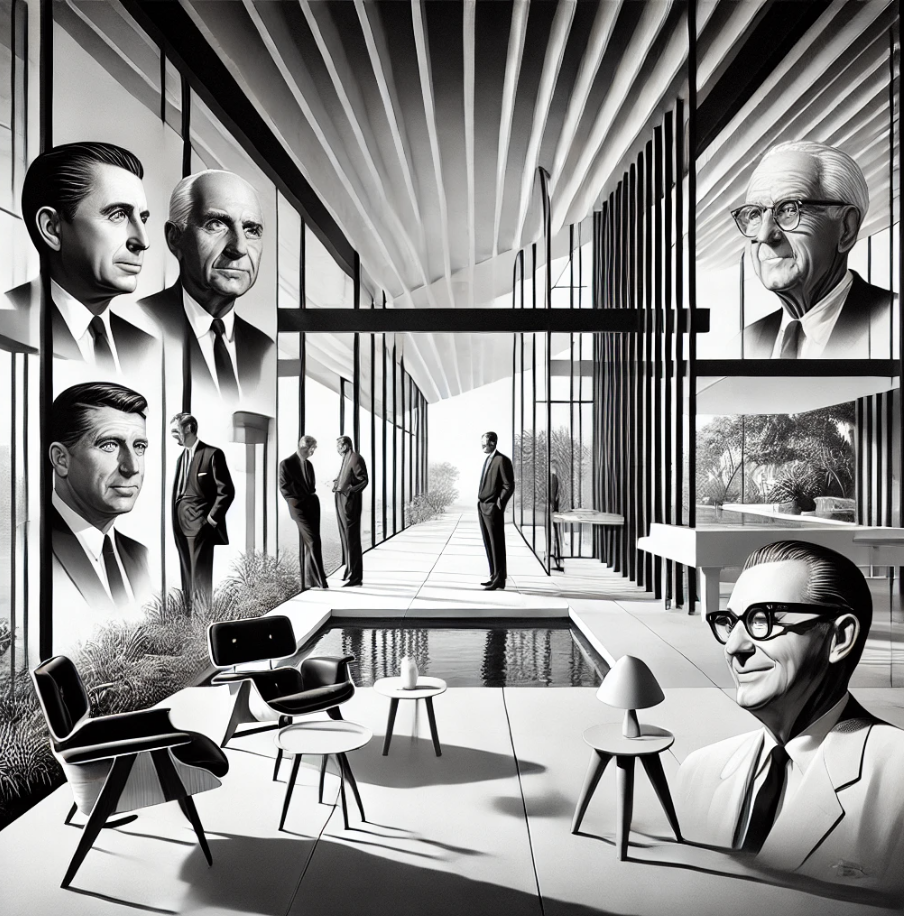Mid-Century Modern Architects
Richard Neutra / Champion of Biorealism
Ray & Charles Eames / Innovators of Multi-Functional Design
Eero Saarinen / Sculptural Modernism
Frank Lloyd Wright / The Forerunner to Organic Architecture
Mid-Century Modern Architects: Icons of Design and Legacy
At the Boyenga Team, we celebrate the legacy of mid-century modern design by highlighting some of the era’s most influential architects. Their philosophies and innovations shaped the aesthetics we recognize today, particularly in California’s Eichler neighborhoods. This page is your guide to understanding the design principles that these visionaries introduced, setting the foundation for modern architecture that balances functionality, natural beauty, and human connection.
Joseph Eichler: Community-Centered Design
Signature Style: As a developer rather than a trained architect, Eichler was driven by a vision of building affordable, stylish homes that brought the outdoors in. Working with top architects, Eichler helped to develop neighborhood layouts that prioritized light, space, and communal connectivity, like those found in Palo Alto's Greenmeadow and San Mateo Highlands. His floor plans incorporated features like atriums, exposed beams, and floor-to-ceiling windows, helping foster a sense of indoor-outdoor living that was unique in the housing market.
Influence: Eichler communities, with their emphasis on shared spaces, remain a testament to his vision of architecture as a means of bringing people together. His work encouraged architects and builders to value simplicity, nature, and transparency within communities.
Richard Neutra: Champion of Biorealism
Signature Style: Neutra’s architectural philosophy, termed “biorealism,” focused on designing structures that promote wellness by connecting inhabitants to their environment. Using extensive glass panels, streamlined forms, and open spaces, Neutra created homes that provided stunning views and a seamless indoor-outdoor feel. The Kaufmann House and other California homes exemplify his approach, focusing on natural integration, which also influenced Eichler’s housing developments.
Influence: Neutra’s focus on healthy living spaces resonates with today’s sustainability and wellness movements. His principles continue to inform modern architecture, particularly in environmentally conscious and wellness-oriented designs.
Charles and Ray Eames: Innovators of Multi-Functional Design
Signature Style: While best known for their contributions to furniture design, Charles and Ray Eames also made significant strides in architectural design. The Eames House (Case Study House No. 8) in Pacific Palisades demonstrated a modular approach to home design, with clean lines, vibrant colors, and an emphasis on simplicity and function. Their contributions to design extended into creating spaces that integrated seamlessly with the environment and fostered a modern, uncluttered lifestyle.
Influence: The Eameses’ principles of functional beauty continue to inspire homeowners, designers, and architects alike, providing models for creative but efficient use of space.
Ludwig Mies van der Rohe: Master of Minimalism
Signature Style: Known for his “less is more” philosophy, Mies van der Rohe created structures like the Farnsworth House that emphasize open space, minimal materials, and a seamless flow. His work on the Farnsworth House is renowned for using minimal partitions and expansive glass to bring the outdoors into everyday living spaces.
Influence: Mies van der Rohe’s minimalistic approach set a standard for mid-century modern design, emphasizing the use of industrial materials, open spaces, and glass to connect with nature. His ideas have influenced not only residential architecture but also office spaces and urban architecture worldwide.
Eero Saarinen: Sculptural Modernism
Signature Style: Saarinen’s work, from the TWA Flight Center to the Tulip Chair, blends sculptural artistry with functionality. His spaces were known for their fluid, organic forms, which introduced a softer, more artistic side to mid-century modernism. His approach has influenced the design of many modern structures, adding a touch of elegance and a focus on form that complements the rigid lines often seen in modernist architecture.
Influence: Saarinen’s approach to form and flow brought a unique, artistic dimension to mid-century modernism, influencing furniture and architecture alike. His designs are timeless, highlighting how architecture can be both functional and artful.
Frank Lloyd Wright: The Forerunner of Organic Architecture
Signature Style: Although Wright’s career predates mid-century modernism, his Usonian houses and organic architecture philosophy greatly influenced mid-century designs. His homes were built with natural materials, open floor plans, and large windows to blur the lines between indoor and outdoor spaces, particularly in projects like Fallingwater and his many California residences.
Influence: Wright’s influence on mid-century modernism is profound; his emphasis on harmony with nature, simplicity, and integration continues to resonate in contemporary architecture.
Custom Conceptual Illustration
Imagine an illustration that brings together these visionary architects in a setting that highlights their architectural contributions: glass walls, exposed beams, minimalist furniture, and serene landscaping. This visual could celebrate their collective legacy and convey the timeless appeal of mid-century modern design.
Discover the Boyenga Team Advantage
The Boyenga Team is your Silicon Valley authority on Eichler homes and mid-century modern properties. With deep expertise in Eichler architecture, real estate trends, and neighborhood communities, we provide invaluable insights for buying or selling your mid-century dream home.
Connect with us
📧 Eichlers@Boyenga.com
📞 408-373-1660







